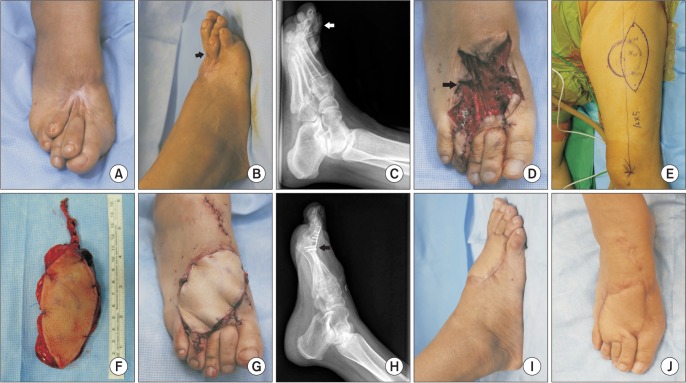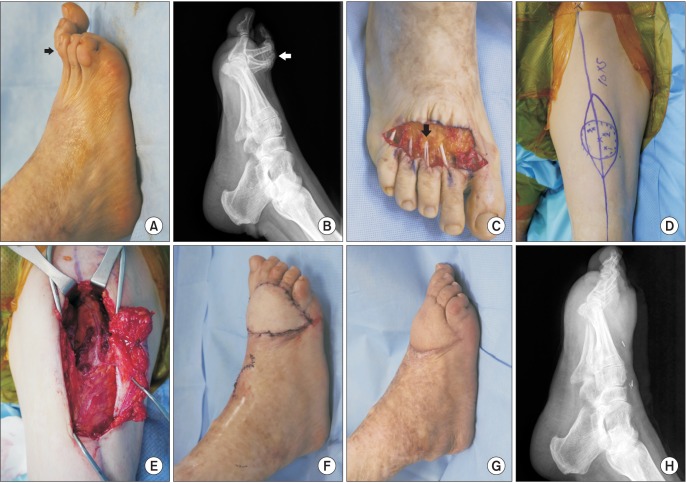Clin Orthop Surg.
2016 Dec;8(4):444-451. 10.4055/cios.2016.8.4.444.
Reconstruction of Postburn Contracture of the Forefoot Using the Anterolateral Thigh Flap
- Affiliations
-
- 1Department of Orthopedic Surgery, Medical Research Institute, Pusan National University Hospital, Busan, Korea. handsurgeon@naver.com
- KMID: 2412328
- DOI: http://doi.org/10.4055/cios.2016.8.4.444
Abstract
- BACKGROUND
Severe forefoot deformities, particularly those involving the dorsum of the foot, cause inconvenience in daily activities of living including moderate pain on the dorsal aspect of the contracted foot while walking and difficulty in wearing nonsupportive shoes due to toe contractures. This paper presents clinical results of reconstruction of severe forefoot deformity using the anterolateral thigh (ALT) free flap.
METHODS
Severe forefoot deformities were reconstructed using ALT flaps in 7 patients (8 cases) between March 2012 and December 2015. The mean contracture duration was 28.6 years.
RESULTS
All the flaps survived completely. The size of the flaps ranged from 8 cm × 5 cm to 19 cm × 8 cm. The mean follow-up period was 10 months (range, 7 to 15 months). There was no specific complication at both the recipient and donor sites. There was one case where the toe contracture could not be completely treated after surgery. All of the patients were able to wear shoes and walk without pain. Also, the patients were highly satisfied with cosmetic results.
CONCLUSIONS
The ALT flap may be considered ideal for the treatment of severe forefoot deformity.
Keyword
MeSH Terms
Figure
Reference
-
1. Uygur F, Duman H, Ulkur E, Celikoz B. Are reverse flow fasciocutaneous flaps an appropriate option for the reconstruction of severe postburn lower extremity contractures? Ann Plast Surg. 2008; 61(3):319–324. PMID: 18724136.
Article2. Chang JB, Kung TA, Levi B, Irwin T, Kadakia A, Cederna PS. Surgical management of burn flexion and extension contractures of the toes. J Burn Care Res. 2014; 35(1):93–101. PMID: 24390110.
Article3. Heimburger RA, Marten E, Larson DL, Abston S, Lewis SR. Burned feet in children: acute and reconstructive care. Am J Surg. 1973; 125(5):575–579. PMID: 4144651.4. Shakirov BM. Evaluation of different surgical techniques used for correction of post-burn contracture of foot and ankle. Ann Burns Fire Disasters. 2010; 23(3):137–143. PMID: 21991213.5. Asuku ME, Ogirima MO. The intravenous canula stylet as intraosseous fixator in the surgical correction of burn scar contractures of the foot in pediatric patients. Burns. 2007; 33(3):378–381. PMID: 17169495.
Article6. Goldberg DP, Kucan JO, Bash D. Reconstruction of the burned foot. Clin Plast Surg. 2000; 27(1):145–161. PMID: 10665363.
Article7. Angrigiani C. Aesthetic microsurgical reconstruction of anterior neck burn deformities. Plast Reconstr Surg. 1994; 93(3):507–518. PMID: 8115505.
Article8. Lo LJ, Yang JY, Wei FC. Free flap transfer in burn reconstruction. Changgeng Yi Xue Za Zhi. 1991; 14(1):8–14. PMID: 2039975.9. Mast BA, Newton ED. Aggressive use of free flaps in children for burn scar contractures and other soft-tissue deficits. Ann Plast Surg. 1996; 36(6):569–575. PMID: 8792964.
Article10. Platt AJ, McKiernan MV, McLean NR. Free tissue transfer in the management of burns. Burns. 1996; 22(6):474–476. PMID: 8884009.
Article11. Battiston B, Antonini A, Tos P, Daghino W, Massazza G, Riccio M. Microvascular reconstructions of traumatic-combined tissue loss at foot and ankle level. Microsurgery. 2011; 31(3):212–217. PMID: 21351140.
Article12. Lin CT, Chang SC, Chen TM, et al. Free-flap resurfacing of tissue defects in the foot due to large gouty tophi. Microsurgery. 2011; 31(8):610–615. PMID: 22009664.
Article13. Lykoudis EG, Dimitrios P, Alexandros BE. One-stage reconstruction of the complex midfoot defect with a multiple osteotomized free fibular osteocutaneous flap: case report and literature review. Microsurgery. 2010; 30(1):64–69. PMID: 19610087.
Article14. Lykoudis EG, Seretis K, Lykissas MG. Free sensate medial plantar flap for contralateral plantar forefoot reconstruction with flap reinnervation using end-to-side neurorrhaphy: a case report and literature review. Microsurgery. 2013; 33(3):227–231. PMID: 23345051.
Article15. Zhang X, Wang X, Wen S, et al. Posterior tibial artery-based multilobar combined flap free transfer for repair of complex soft tissue defects. Microsurgery. 2008; 28(8):643–649. PMID: 18846571.
Article16. Ou KL, Tzeng YS, Yu CC, Chen TM. Resurfacing tophaceous gout in the foot with anterolateral thigh flap. Microsurgery. 2010; 30(1):79–82. PMID: 19670239.
Article17. El-Gammal TA, El-Sayed A, Kotb MM, et al. Dorsal foot resurfacing using free anterolateral thigh (ALT) flap in children. Microsurgery. 2013; 33(4):259–264. PMID: 23280772.
Article18. Wei FC, Jain V, Celik N, Chen HC, Chuang DC, Lin CH. Have we found an ideal soft-tissue flap? An experience with 672 anterolateral thigh flaps. Plast Reconstr Surg. 2002; 109(7):2219–2226. PMID: 12045540.
Article19. Shakirov BM. Surgical treatment of post burn bent contractures of the foot in children. Clin Res Foot Ankle. 2015; 3(1):1000166. DOI: 10.4172/2329-910X.1000166.
Article20. Shakirov BM. Foot postburn bent contracture deformities. Burns. 2007; 33(8):1054–1058. PMID: 17573198.
Article21. Kenney JG, DiMercurio S, Angel M. Tissue-expanded radial forearm free flap in neck burn contracture. J Burn Care Rehabil. 1990; 11(5):443–445. PMID: 2246314.
Article22. Constantino JA, Rodriguez-Yuste JA, Quiles M. Severe post-burn hyperextension of metatarsophalangeal joints in a child with bilateral foot contracture. J Foot Ankle Surg. 2007; 46(1):48–51. PMID: 17198953.
Article23. Lui TH. Arthroscopic-assisted correction of claw toe or overriding toe deformity: plantar plate tenodesis. Arch Orthop Trauma Surg. 2007; 127(9):823–826. PMID: 17004077.
Article24. Tsai J, Liao HT, Wang PF, Chen CT, Lin CH. Increasing the success of reverse sural flap from proximal part of posterior calf for traumatic foot and ankle reconstruction: patient selection and surgical refinement. Microsurgery. 2013; 33(5):342–349. PMID: 23653382.
Article25. De Lorenzi F, van der Hulst R, Boeckx W. Free flaps in burn reconstruction. Burns. 2001; 27(6):603–612. PMID: 11525856.
Article26. Robson MC, Smith DJ Jr, VanderZee AJ, Roberts L. Making the burned hand functional. Clin Plast Surg. 1992; 19(3):663–671. PMID: 1633673.
Article27. Ao M, Uno K, Maeta M, Nakagawa F, Saito R, Nagase Y. De-epithelialised anterior (anterolateral and anteromedial) thigh flaps for dead space filling and contour correction in head and neck reconstruction. Br J Plast Surg. 1999; 52(4):261–267. PMID: 10624291.
Article28. Kimata Y, Uchiyama K, Ebihara S, et al. Comparison of innervated and noninnervated free flaps in oral reconstruction. Plast Reconstr Surg. 1999; 104(5):1307–1313. PMID: 10513910.
Article
- Full Text Links
- Actions
-
Cited
- CITED
-
- Close
- Share
- Similar articles
-
- Reconstruction of Forefoot Degloving Injury with Innervated Anterolateral Thigh Free Flap
- Correction of Post Burn Extension Contracture of 4, 5th Toes Using Free Flap
- Total Tongue Reconstruction with Folded Anterolateral Thigh Free Flap
- Anatomical Characteristics and Versatility of the Anterolateral Thigh Flap
- Reconstruction of the Tissue Defects of Extremities with Anterolateral Thigh Free Flap



